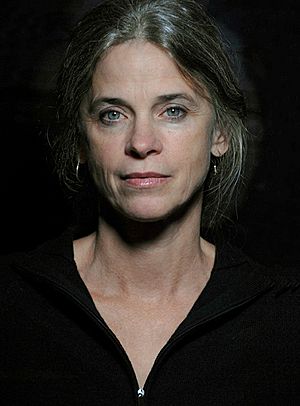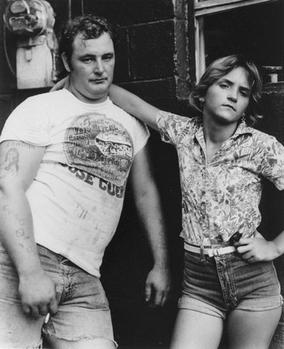Sally Mann facts for kids
Quick facts for kids
Sally Mann
|
|
|---|---|

Mann in 2007
|
|
| Born |
Sally Turner Munger
May 1, 1951 Lexington, Virginia, U.S.
|
| Education | Hollins College (BFA, MA) |
| Known for | Photography |
| Awards |
|
Sally Mann (born Sally Turner Munger; May 1, 1951) is an American photographer. She is famous for her large black and white photos of people and places around her. This includes her children, her husband, and the countryside where she lives. She also takes pictures of herself.
Contents
Early Life and Education
Sally Mann was born in Lexington, Virginia, in 1951. She was the youngest of three children. Her father, Robert S. Munger, was a doctor, and her mother, Elizabeth Evans Munger, managed a bookstore. Sally's father was very supportive and encouraged her to explore her interests. He introduced her to photography, and his old 5x7 camera inspired her to use large cameras later on.
Sally started taking pictures when she was sixteen. Many of her photos and writings are connected to Lexington, Virginia. She finished high school at The Putney School in 1969. She then went to Bennington College and Friends World College. She earned her Bachelor of Arts degree in 1974 and a Master of Arts degree in creative writing in 1975 from Hollins College (now Hollins University).
Sally says she first got into photography at Putney because she liked being in the darkroom. She took her first public photo of a classmate there. Sally Mann has never had formal photography lessons and says she "never reads about photography."
Early Photography Career
After college, Sally Mann worked as a photographer at Washington and Lee University. In the mid-1970s, she photographed the building of a new law school. This led to her first art show in 1977 at the Corcoran Gallery of Art in Washington, DC. A book of her photos from this time, called "The Lewis Law Portfolio," was also published. Some of these unique photos were in her first book, Second Sight, which came out in 1984.
While Sally explored different types of photography in the 1970s, she found her true style with her book, At Twelve: Portraits of Young Women, published in 1988.
At Twelve: Portraits of Young Women
Her second photo collection, At Twelve: Portraits of Young Women, came out in 1988. It caused some discussion. The pictures showed the "confusing feelings and growing identities of teenage girls." The way she printed them gave the photos a strong and thoughtful mood.
In the book's introduction, writer Ann Beattie said that when a girl is twelve, she often wants more independence from adults. It's a time when girls wish for freedom, and adults realize they need to let their children grow. Beattie noted that Mann's photos don't make the world seem overly glamorous or unpleasant. Instead, they show the girls as "vulnerable in their youthfulness" but also highlight their inner strength.
Later Photography Work
In the mid-1990s, Sally Mann started taking pictures of landscapes. She used a special old camera and a technique called "wet plate collodion." This method uses glass plates coated with chemicals that are exposed while still wet. This gives the photos a unique, sometimes blurry, and dreamlike look with clear details in the center. These landscape photos were shown in her exhibitions like Sally Mann – Mother Land: Recent Landscapes of Georgia and Virginia in 1997 and Deep South: Landscapes of Louisiana and Mississippi in 1999.
Sally Mann has been the focus of two documentaries. The first, Blood Ties (1994), was nominated for an Academy Award. The second, What Remains: The Life and Work of Sally Mann (2005), was also nominated for an Emmy award. These films show her artistic process and her life.
Mann often uses antique view cameras from the 1890s. These cameras have wooden frames and accordion-like bellows. They help soften the light, making her pictures feel timeless.
Her fifth book, What Remains, published in 2003, explores themes of life, death, and memory. It includes photos of old remains, a site on her property, and the Antietam battlefield from the American Civil War. The book ends with close-up photos of her children, bringing a sense of hope and love.
Mann's sixth book, Deep South (2005), features 65 black-and-white landscape photos taken from 1992 to 2004. These pictures show "haunted landscapes of the South," including battlefields and old mansions.
Her seventh book, Proud Flesh (2009), is a six-year study of her husband, Larry Mann, and how a health condition affected him. Sally photographed him using the collodion wet plate process. These photos are honest and touching portraits of her husband.
In 2010, her eighth book, The Flesh and The Spirit, was released with a big exhibition at the Virginia Museum of Fine Arts. This book included new and old works, like self-portraits, landscapes, and photos of her husband and children. The main idea of the book is the human body and its journey through life and health.
In 2015, Mann released her ninth book, Hold Still: A Memoir with Photographs. This book combines her life story with her photos. It talks about her childhood, her long marriage, her love for the land, and important people in her life. The book was a finalist for the 2015 National Book Award.
Her tenth book, Remembered Light: Cy Twombly in Lexington (2016), offers a look inside the studio of artist Cy Twombly. It shows his creative space, including leftover materials and marks.
Mann's eleventh book, Sally Mann: A Thousand Crossings (2018), is a large collection of her work from 40 years. It was published with a major exhibition at the National Gallery of Art. In her recent projects, Mann has explored themes of race and the history of slavery in the South. This includes portraits of Black men and photos of historic African American churches.
Personal Life
Sally Mann was born and grew up in Virginia. She often talks about the strong bond she had with Virginia Carter, a Black woman who helped raise her and her two brothers. Virginia Carter was a remarkable woman who made sure her own children went to college despite challenges. She passed away in 1994.
In 1969, Sally met Larry Mann, and they married in 1970. Larry Mann is a lawyer. They live together in their home, which they built on Sally's family farm in Lexington, Virginia.
Sally and Larry have three children: Emmett (born 1979), Jessie (born 1981), and Virginia (born 1985). Emmett worked in the Peace Corps, Jessie became an artist, and Virginia became a lawyer.
Sally Mann also loves endurance horse riding. In 2006, she had an accident while riding her horse, which led to a broken back. It took her two years to recover. During this time, she created a series of self-portraits using an old photography method called ambrotype. These photos were shown in 2010 as part of her exhibition Sally Mann: the Flesh and the Spirit.
Film and Television
- Blood Ties: The Life and Work of Sally Mann. Directed by Steven Cantor and Peter Spirer. (1992)
- "Giving Up the Ghost". Egg, The Arts Show. (2002)
- "Place". Episode One. Art 21. (2002)
- What Remains: The Life and Work of Sally Mann. Directed by Steven Cantor. (2004)
- "Some Things Are Private". Playwrights Deborah Salem Smith, Laura Kepley. (2008)
- "The Genius of Photography: We Are Family". Episode 6. (2008)
- "Thalia Book Club: Sally Mann Hold Still". Ann Patchett, Symphony Space (May 13, 2015)
Awards
- 2001: Time magazine called Mann "America's Best Photographer."
- 2006: Received an honorary degree from the Corcoran College of Art + Design.
- 2012: Became an Honorary Fellow of the Royal Photographic Society (UK).
- 2016: Won the Andrew Carnegie Medal for Excellence in Nonfiction for Hold Still: A Memoir in Photographs.
- 2020: Received the Centenary Medal from the Royal Photographic Society.
- 2021: Joined the International Photography Hall of Fame.
- 2021: Won the Prix Pictet's ninth global photography award.
Collections
Sally Mann's work is kept in many important art collections, including:


